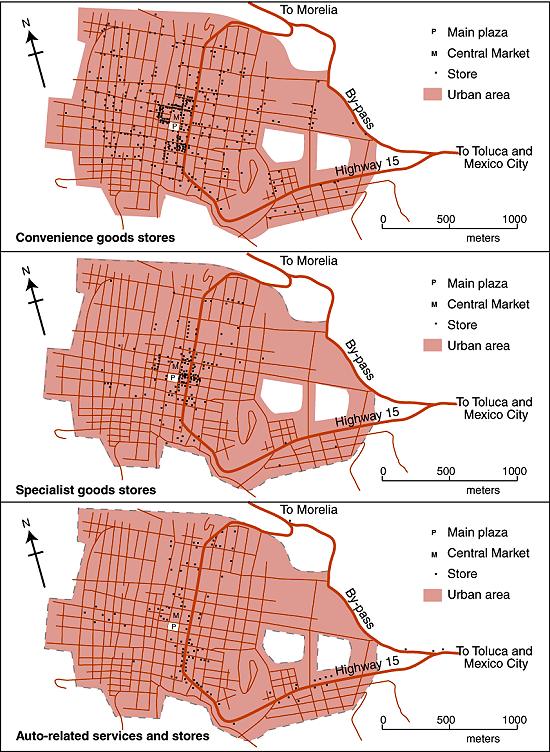The maps below show the distribution in 1980 of three distinct types of commercial establishments in the mid-sized city of Zitácuaro in Michoacán.

Retail activities in Zitácuaro, Michoacán. Color version of Figure 22.3 of Geo-Mexico: the geography and dynamics of modern Mexico. All rights reserved.
Founded hundreds of years earlier, the city grew spontaneously, almost organically, with little planning; its population by 1980 was 100,000. Cars were not a necessity. The residents of Zitácuaro did not have to walk far to purchase their basic daily shopping needs. Convenience stores (top map) existed in every neighborhood. Many (145 out of 393) were genuine “corner stores”, strategically located at street intersections. On average, each convenience store served about 250 residents.
More specialist stores (middle map), selling so-called “shopping goods” such as clothes and furniture, had a very different distribution. A few were located in residential areas, but most were concentrated in the heavily trafficked central area of the city, in the narrow streets close to the main plaza or zócalo, west of the main highway.
By 1980, a bypass had been opened enabling through traffic to avoid the main congested highway through the center of the city. However, the distribution of specialist stores does not appear to show any close connection to either the old highway or the new bypass.
This contrasts with the distribution of stores connected to auto services (gas stations, auto parts, tire repairs, mechanics) where the preferred locations in 1980 were close to the main highway (bottom map). In the succeeding years, this distribution has changed somewhat. Many of these services have now relocated to the by-pass to better serve the passing traffic.
This post is an excerpt from Geo-Mexico: the geography and dynamics of modern Mexico. Chapters 21 and 22 of Geo-Mexico analyze Mexico’s 500-year transition to an urban society and the internal geography of Mexico’s cities. Chapter 23 looks at urban issues, problems and trends. To preview more parts of the book, click here and use amazon.com’s “Look Inside” feature. Buy your copy today!
Sorry, the comment form is closed at this time.